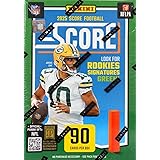
Inside the NFL’s New Kickoff Revolution: How the Rams and Panthers Are Outsmarting the Competition
Ever wonder how some NFL teams seem to crack the code while others are still fumbling in the dark? Take the Panthers and Rams, for example. While most squads are letting opponents start drives at the 30-yard line or beyond under the NFL’s revamped kickoff rules, these two have mastered the art of pinning foes just inside the 22-yard line. That’s not just a footnote—that’s a game-changing edge. As the league experiments with dynamic kickoffs to boost returns and reduce concussions, the Panthers and Rams are quietly rewriting the playbook. What’s their secret sauce—clever positioning, crafty kick styles, or just a dash of “cheat code” magic? Let’s dig into how these teams are rewiring kickoff strategies and flipping field position into points before their rivals can even blink. LEARN MORE.
The Panthers have limited opponents to an average starting point near the 21-yard line. The Rams are a close second, while no other team is within 4 yards. We look at why.
While some teams are still trying to figure out how to manage the new kickoff rules, the Los Angeles Rams and Carolina Panthers seem to have found a cheat code.
For what the NFL said was for safety-related reasons, the league implemented the “dynamic kickoff” in 2024. The kickoff touchback spot was the 30-yard line, with the main goal being to encourage more returns by creating a less dangerous and more dynamic play.
And the league announced it had been a successful experiment, with a 43% reduction in concussion rates during kickoffs. But at the same time (and probably related), the percentage of touchbacks on kickoffs in 2024 was 64.3% – the second-highest rate in a single season behind only 73.0% in the previous 2023 campaign.
The new format may have succeeded in one respect, but it had failed in a couple of others. Kickoff returns were not more common, and touchbacks had not become rarer – or at least not as rare as the league hoped.
So, the NFL decided to call an audible heading into the 2025 season, announcing that the touchback spot would be changed to the 35-yard line – which matches the old XFL rule on which the dynamic kickoff change was based. In theory, kicking teams would be more likely to try to pin the receiving team back and lead to more returns.
That’s been the case so far as the touchback rate is all the way down to 17.0%, which is on pace to be the lowest in a single season since it was 16.7% in 1998. And 77.3% of all kickoffs have been returned through three weeks, which is the highest return rate since it was 80.1% in 2010.
It’s also up from 21.8% in 2023 and 32.8% last season (the two lowest rates of the past 30 years).
It’s never a good thing – in any sport – when scoring is down. And that was the case when the NFL saw its league-wide points per game drop from 49.6 in 2020 to 46.0 in 2021 to 43.8 in 2022 and 43.5 in 2023.
So perhaps it was very much a welcome side effect when league-wide scoring rose to 45.8 both in 2024 and through three weeks this season. It makes sense since the average drive start following kickoffs has risen from about the 25-yard line (25.2 in 2022 and 25.1 in 2023) to close to the 30 over the past two seasons (29.6 in 2024 and 29.5 in 2025).

The majority of the league’s opponents are starting near the 30-yard line and the Denver Broncos (32.1), Tennessee Titans (32.4), Indianapolis Colts (33.0), New Orleans Saints (33.2), Las Vegas Raiders (33.6) and San Francisco 49ers (33.8) are all opening drives past the 32 on average under the new kickoff rules.
But the Rams and Panthers have managed to bring the game back to the early 2010s, when the average field goal position was between the 21- and 22-yard lines for five years straight (2011-15).
The Panthers easily lead the league heading into Week 4, limiting opponents to an average starting point near the 21-yard line (21.1). The Rams are a close second (22.1), while no other team has an average opponent starting point within 4 yards of those two teams.

So how are they doing it? There’s not a ton in the way of tricky kickoff alignment, as every team must line up with at least one foot on the opponent’s 40-yard line and players can’t move until the ball hits the ground or is touched by a returner.
But there does seem to be a difference in the way these teams are approaching the hang time, direction and distance of the actual kick.
First off, they aren’t kicking it deep and trying to land the ball close to the goal line as one might expect. After all, the extended touchback that puts the ball at the 35-yard line is only when the ball lands in the end zone. So if a kicker drops the ball on the 5 and it bounces in, the other team starts at the 20.
The Rams’ Joshua Karty ranks 30th in the league in average landing distance from the goal at 8.4. He’s also last in average hang time at just 2.71 seconds and is the only kicker in the NFL who hasn’t had a kickoff that landed outside the numbers.
The Panthers, similarly, rank 27th in both average landing distance from the goal line at 6.6 and average hang time at 3.12, and they’ve only kicked outside the numbers three times.
So the secret sauce might be to kick off low, short (not too close to the goal line) and in the middle, right?
Yes, but the biggest factor might be hang time. Seven of the top 10 in average opponent field position after the kickoff are in the bottom half of the league in that category.

The strategy doesn’t stop there, however. A key to both the Rams and Panthers’ success appears to be how both Karty and Carolina’s Ryan Fitzgerald are kicking it.
“Something that caught the attention of many across the league on various social media platforms was Karty’s knuckleball-style kickoff, which was giving the Eagles problems the entire first half and the third quarter (in Week 3),” Rams scribe Matthew Colvin wrote for USA Today. “He forced multiple muffed kicks that gave the Rams a big advantage, forcing the Eagles to start with bad field position on most of their drives.”
Fitzgerald’s approach has also been described as knuckleball-style squib kicks, making it tough to field and allowing defenders to close in.
Panthers special teams coordinator Tracy Smith has downplayed the fact that his team has gotten ahead of the curve when it comes to the new rules, though he has affectionately referred to the unit’s approach as “dirty” kickoffs.
“I think it’s just the results have been different in a small basket of kicks,” he told reporters. “But we’re not kinda off the charts in any way as far as what we’re trying to do, compared to anybody else. So I wouldn’t characterize it that way. But anything you do as a football team is based on who the players are on your team.”
Even so, the numbers tell a different story. To further the point, teams starting between the 21- and 22-yard lines have scored points 23.5% of the time and gone down for a touchdown on 5.9% of those drives in 2025.
Teams that have opened drives between the 30- and 31-yard lines have put points on the board in 36.2% of those drives and marched down for a TD on 18.8% so far.
The Rams and Panthers have given themselves a major advantage early on.
Trevor Goldstein, Kyle Cunningham-Rhoads and Greg Gifford contributed. Research support provided by Brady Olson. For more coverage, follow along on social media on Instagram, Bluesky, Facebook and X.
The post How the Rams and Panthers Are Finding Success Under the NFL’s New Kickoff Rules appeared first on Opta Analyst.

































Post Comment